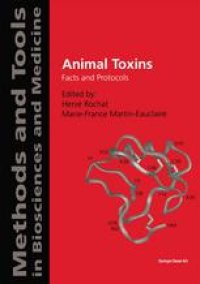
Ebook: Animal Toxins: Facts and Protocols
- Tags: Life Sciences general, Biomedicine general
- Series: Methods and Tools in Biosciences and Medicine
- Year: 2000
- Publisher: Birkhäuser Basel
- Edition: 1
- Language: English
- pdf
It is now something of a truism to say that natural toxins form a major compo nent of the molecular tools used increasingly frequently by the ever growing number of laboratories of various kinds. Evidence for this is provided not only by the increasing number of firms including such toxins in their catalogues but also by the large number of demands received by those who discover new tox ins. This book is designed to facilitate the work of scientists interested in explor ing a new domain of toxicology or in using toxins as tools for research. The length of this book has been kept reasonable by concentrating on animal tox ins, most of which are polypeptides. The venom of each animal contains a large number of toxins, which may be similar in terms of their physical and chemical properties and are therefore difficult to purify. However, their pharmacological activities may be very differ ent. These toxins are extremely active, and it is therefore necessary to demon strate conclusively that the activity observed really does correspond to the newly characterized molecule.
Natural toxins form a major component of the molecular tools used increasingly frequently by the ever growing number of laboratories of various kinds. Evidence for this is provided not only by the increasing number of firms including such toxins in their catalogues but also by the large number of demands received by those who discover new toxins. Twenty chapters survey important aspects of toxin origin, their structure and molecular mechanism, and their cellular and pathogenic effects. In addition, the text provides comprehensive and specific methodology for the application of these toxins in the research laboratory. This begins with the description of the method of extraction, biochemical and pharmacological characterization, and assessment of purity, and continues with methods for chemical modification, e.g. labelling, and eventually describes applications in pharmacological studies in vivo and/or in vitro. The length of this book has been kept reasonable by concentrating on animal toxins,...